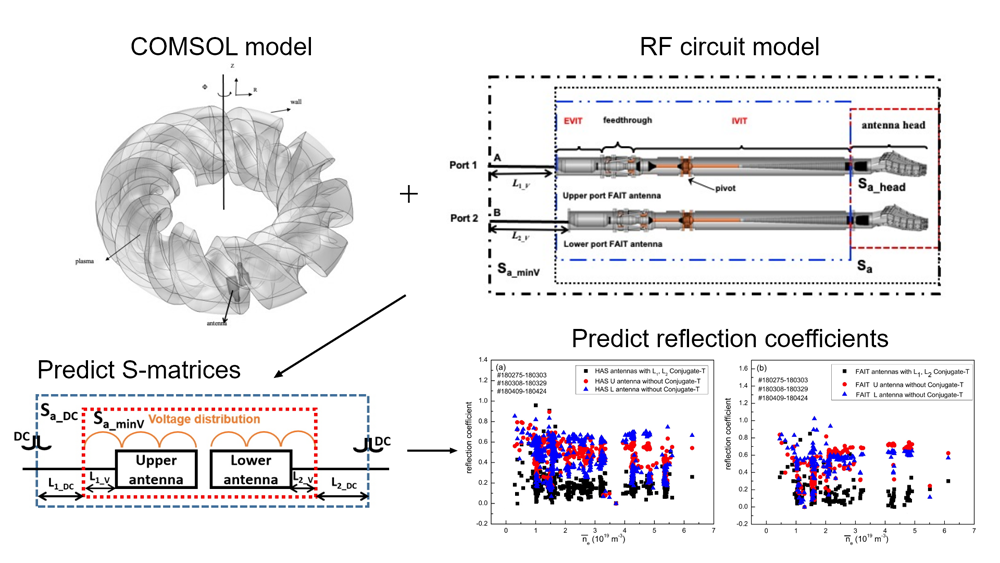Design of an optimized load-resilient Conjugate T for the ICRH system in the LHD to maintain low reflection coefficients over a wide range of parameters
The S-matrices of upper and lower ICRH antennas are measured with real plasma for the LHD. Then the measured S-matrices are compared with a hybrid circuit/3DLHDAP simulation, and the theoretical results are in agreement with the experimental ones. Finally, a conjugate-T circuit for antennas is optimized according to the measured S-matrices by hybrid circuit/3DLHDAP, which can obtain low reflection (less than 0.4) without controlling impedance matching devices for FAIT and HAS antennas in a wide plasma parameter range.

The ICRH antenna coupling resistance changes rapidly (less than 1 ms) due to changing plasma conditions (such as plasma start-up, L-H transition, edge localized mode (ELM)...). The ICRH matching device of the LHD, based on dielectric liquid stubs, is far too slow (time response greater than or equal to 10 ms) to cope with fast load variations, and the reflection power increases abruptly. The conjugate-T system can handle this most challenging condition and minimize the voltage standing wave ratio (VSWR) with a proper choice of matching point. In order to increase ICRH injection power with the fast coupling changes, the load-resilient conjugate-T device for the LHD is designed by the hybrid circuit/3DLHDAP code and experimental results.
The LHD research group, in collaboration with D. Du at the Department of Mathematics and Physics, South China University, J. G. Kwak at the Korea Institute of Fusion Energy, Q. X. Yang and H. Zhou at the Institute of Plasma Physics, Chinese Academy of Sciences, S. X. Hu at the Department of Electrical Engineering, South China University, Z. W. Huang, X. Y. Gong, Z. K. Gao, and D. Xiang at the Department of Nuclear Science and Technology, South China University, worked on measuring the S-matrices of the ICRH antenna system (HAS and FAIT) with hydrogen plasma, correctly predicting them, and designing the load-resilient conjugate-T device for the HAS and FAIT antenna system.
Experiments to measure the relationships between S-matrices and line-averaged electron density, magnetic field and coupling distance, i.e. the distance between plasma confined by the Last Closed Flux Surface (LCFS) and a Faraday screen, was performed for the first time in the 24th LHD experimental campaign in 2022. ICRH power modulation with rectangular waveform and phase scan experiments was performed using ICRH, ECH and NBI to heat the plasma.
A program hybrid circuit/3DLHDAP (three-dimensional LHD antenna with plasma) was also developed, which consists of two parts: 3DLHDAP (three-dimensional LHD antenna with plasma), and an RF circuit model to calculate the S-parameters and optimize the load-resilient conjugate-T device for the LHD ICRH antenna system. The hybrid circuit/3DLHDAP simulations are in agreement with the experimental results. The mutual coupling of the toroidal HAS antenna is larger than that of the poloidal FAIT antenna over a wide range of densities. When the density and coupling distance increase, under a magnetic field on a magnetic axis of 2.75 T and 1.0 T, within a certain density change range, at the minimum voltage position with vacuum injection, the change rule of Sa_minV_11 and Sa_minV_22 of the antennas with density is opposite to that with the coupling distance. This means that under certain conditions, adjusting the coupling distance can compensate the S-parameter changes caused by plasma density variation, while keeping the minimum voltage position fixed, and can make impedance matching easier to achieve a during long-pulse operation.
Based on the obtained S-parameters, conjugate T-circuits for the HAS and FAIT antennas are designed with the hybrid circuit/3DLHDAP, which can keep the reflection coefficients low (less than 0.4) without controlling the impedance matching device over a wide range of plasma parameters. The related results can provide some guidance for the high-power long-pulse operation of the ICRH antenna system in a fusion device.
This research result was published on October 6, 2023 in Nuclear Fusion, a journal on controlled thermonuclear fusion by the International Atomic Energy Agency.
Publication
Glossary
*S-matrix: A matrix used to evaluate the input/output characteristics of electrical and electronic circuits, also called a scattering matrix. In a circuit element with several input/output terminal pairs (ports), for example, when electromagnetic waves are input from one port and output to another, the complex electric field amplitude at each port is the S-parameter or scattering coefficient, and they are arranged in matrix form.
